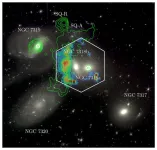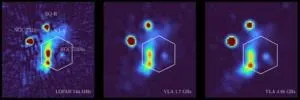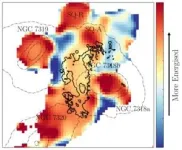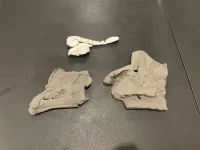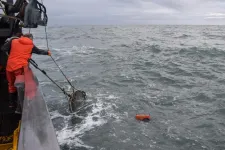(Press-News.org) A massive collision of galaxies sparked by one travelling at a scarcely-believable 2 million mph (3.2 million km/h) has been seen in unprecedented detail by one of Earth's most powerful telescopes.
The dramatic impact was observed in Stephan's Quintet, a nearby galaxy group made up of five galaxies first sighted almost 150 years ago.
It sparked an immensely powerful shock akin to a "sonic boom from a jet fighter" – the likes of which are among the most striking phenomena in the Universe.
Stephan's Quintet represents "a galactic crossroad where past collisions between galaxies have left behind a complex field of debris", which has now been reawakened by the passage of the galaxy, NGC 7318b.
The collision was spotted by a team of scientists using the first observations from the new 20-million Euro (£16.7million) William Herschel Telescope Enhanced Area Velocity Explorer (WEAVE) wide-field spectrograph in La Palma, Spain.
This cutting-edge, next generation science facility will not only reveal how our Milky Way galaxy was built up over billions of years, but also offer new insights into millions of other galaxies across the Universe.
The discovery of NGC 7318b smashing through Stephan's Quintet was observed by a team of more than 60 astronomers and has been published today in Monthly Notices of the Royal Astronomical Society.
The system is an ideal laboratory to understand the chaotic and often violent relationship between galaxies, which is why it was the focus of the first-light observation by the WEAVE Large Integral Field Unit (LIFU).
Lead researcher Dr Marina Arnaudova, of the University of Hertfordshire, said: "Since its discovery in 1877, Stephan's Quintet has captivated astronomers, because it represents a galactic crossroad where past collisions between galaxies have left behind a complex field of debris.
"Dynamical activity in this galaxy group has now been reawakened by a galaxy smashing through it at an incredible speed of over 2 million mph (3.2 million km/h), leading to an immensely powerful shock, much like a sonic boom from a jet fighter."
The international team has uncovered a dual nature behind the shock front, previously unknown to astronomers.
"As the shock moves through pockets of cold gas, it travels at hypersonic speeds – several times the speed of sound in the intergalactic medium of Stephan’s Quintet* – powerful enough to rip apart electrons from atoms, leaving behind a glowing trail of charged gas, as seen with WEAVE," Dr Arnaudova said.
However, when the shock passes through the surrounding hot gas, it becomes much weaker, according to PhD student Soumyadeep Das, of the University of Hertfordshire.
He added: "Instead of causing significant disruption, the weak shock compresses the hot gas, resulting in radio waves that are picked up by radio telescopes like the Low Frequency Array (LOFAR)."
The new insight and unprecedented detail came from WEAVE's LIFU, combining data with other cutting-edge instruments such as the LOFAR, the Very Large Array (VLA), and the James Webb Space Telescope (JWST).
WEAVE is a state-of-the-art super-fast mapping device that has been connected to the William Herschel Telescope to analyse the composition of stars and gas both in the Milky Way and in distant galaxies.
This is done with the help of a spectroscope, which reveals the elements that stars are made of by generating a bar code-style pattern within a prism of colours that make up a source of light.
It was designed and built following a multi-lateral agreement by France, Italy and the countries of the Isaac Newton Group of Telescopes partnership (the UK, Spain and the Netherlands).
Astronomers hope that WEAVE will help reveal how our galaxy formed in unprecedented detail and revolutionise our understanding of the Universe.
Dr Daniel Smith, of the University of Hertfordshire, said: "It's really neat work that Marina has put together with this large team, but this first WEAVE science paper also represents just a taste of what is to come over the next five years now that WEAVE is becoming fully operational."
Professor Gavin Dalton, WEAVE principal investigator at RAL Space and the University of Oxford, said: "It's fantastic to see the level of detail uncovered here by WEAVE.
"As well as the details of the shock and the unfolding collision that we see in Stephan's Quintet, these observations provide a remarkable perspective on what may be happening in the formation and evolution of the barely resolved faint galaxies that we see at the limits of our current capabilities."
Dr Marc Balcells, director of the Isaac Newton Group of Telescopes, said: "I'm excited to see that the data gathered at the WEAVE first light already provide a high-impact result, and I'm sure this is just an early example of the types of discoveries that will be made possible with WEAVE on the William Herschel Telescope in the coming years."
ENDS
Media contacts
Sam Tonkin
Royal Astronomical Society
Mob: +44 (0)7802 877700
press@ras.ac.uk
Robert Massey
Royal Astronomical Society
Mob: +44 (0)7802 877699
press@ras.ac.uk
Science contacts
Dr Marina Arnaudova
University of Hertfordshire
m.i.arnaudova@gmail.com
Soumyadeep Das
University of Hertfordshire
soumyadeep.das.m44@gmail.com
Dr Daniel Smith
University of Hertfordshire
d.j.b.smith@herts.ac.uk
Images and captions
WEAVE's view of Stephan’s Quintet
Caption: WEAVE data overlaid on a James Webb Space Telescope image of Stephan's Quintet, with green contours showing radio data from the Low Frequency Array (LOFAR) radio telescope. The orange and blue colours follow the brightness of Hydrogen-alpha obtained with the WEAVE LIFU, which trace where the intergalactic gas is ionised. The hexagon denotes the approximate coverage of the new WEAVE observations of the system, which is 36 kpc wide (similar in size to our own galaxy, the Milky Way).
Credit: University of Hertfordshire
Radio observations
Caption: Radio observations of Stephan's Quintet at different frequencies, taken by the Low Frequency Array (LOFAR) and the Very Large Array (VLA). The red colours indicate strong radio emission coming from the shock front, as well as from some of the galaxies in the group and beyond.
Credit: University of Hertfordshire
High-energy plasma
Caption: An image revealing the age of high-energy plasma in Stephan's Quintet, as captured by radio observations with the VLA and LOFAR. The blue colours indicate older, low-energy plasma, while the orange and yellow areas mark regions that are being actively energised. The thin, dashed lines outline the location of the galaxies in the group, while the black solid lines trace the shock region identified with WEAVE data, which perfectly matches the areas where this plasma is being re-accelerated by the collision between NGC 7318b and the group.
Credit: University of Hertfordshire
Decomposition of gas
Caption: WEAVE decomposition of gas in Stephan's Quintet, overlaid on a JWST image. The red highlights gas shocked by the collision, while green and blue shows star-forming regions. The purple areas represent bubbles with an unknown origin. The black contours show neutral Hydrogen, and its location relative to the shocked gas (in red) suggests that is where it comes from.
Credit: University of Hertfordshire
WEAVE
Caption: The WEAVE prime-focus corrector and positioner at the William Herschel telescope in La Palma, Spain.
Credit: ING
Further information
The paper 'WEAVE First Light observations: Origin and Dynamics of the Shock Front in Stephan’s Quintet', by Dr Marina Arnaudova et al. will be published in Monthly Notices of the Royal Astronomical Society on Friday 22 November 2024. For an advance copy of the paper, email press@ras.ac.uk
*This is estimated to be ~440km/s.
Notes for editors
About WEAVE
In 2016, a multi-lateral agreement to design and build WEAVE was signed by the countries of the Isaac Newton Group of Telescopes (ING) partnership (the UK, Spain and the Netherlands), joined by France and Italy, with each country contributing major components as listed below, and with the ING providing auxiliary systems and overall project management.
The consortium is led by Gavin Dalton from the University of Oxford and RALSpace as Principal Investigator, Scott Trager from University of Groningen as Project Scientist, Don Carlos Abrams from ING as Project Manager, and Chris Benn from ING as Instrument Scientist.
The main components of WEAVE are:
Fibre positioner, developed by the University of Oxford in the UK, with support from the Instituto de Astrofísica de Canarias (IAC) in Spain.
Prime-focus system, designed by ING, IAC and SENER, provided by the IAC and manufactured by SENER. Support from Konkoly Observatory (HU). Lenses were polished by KiwiStar in New Zealand, funded from STFC, NOVA, INAF, IAC and ING, and mounted at SENER Aeroespacial (ES) by SENER and ING.
Spectrograph, built by NOVA in the Netherlands with optical design by RAL Space in the UK, optics manufactured at INAOE (MX) and with support from INAF (IT) and the IAC.
Field rotator, provided by IAC and manufactured by IDOM (ES). Optical fibres, provided by the Observatoire de Paris in France, manufactured in France, Canada and USA.
LIFU, built by NOVA (NL).
CCD detectors system, provided by Liverpool John Moores University in the UK. Data processing, analysis and archiving led by the University of Cambridge (UK), IAC (ES) and FGG-INAF (IT) respectively.
Observatory control system, built by the ING.
WEAVE's construction has been funded by the Science and Technology Facilities Council (STFC, UK), the Netherlands Research School for Astronomy (NOVA, NL), the Dutch Research Council (NWO, NL), the Isaac Newton Group of Telescopes (ING, UK/NL/ES), the Instituto de Astrofísica de Canarias (IAC, ES), the Ministry of Economy and Competitiveness (MINECO, ES), the Ministry of Science and Innovation (MCI, ES), the European Regional Development Fund (ERDF), the National Institute for Astrophysics (INAF, IT), the French National Centre for Scientific Research (CNRS, FR), Paris Observatory – University of Paris Science and Letters (FR), Besançon Observatory (FR), Region île de France (FR), Region Franche-Comté (FR), Instituto Nacional de Astrofísica, Óptica y Electrónica (INAOE, MX), National Council for Science and Technology (CONACYT, MX), Lund Observatory (SE), Uppsala University (SE), the Leibniz Institute for Astrophysics (AIP, DE), Max-Planck Institute for Astronomy (MPIA, DE), University of Pennsylvania (US), and Konkoly Observatory (HU).
About the William Herschel Telescope
The William Herschel Telescope (WHT) is operated on the island of La Palma by the Isaac Newton Group of Telescopes (ING) in the Spanish Observatorio del Roque de los Muchachos of the Instituto de Astrofísica de Canarias (IAC). The ING is funded by the Science and Technology Facilities Council (STFC-UKRI) of the United Kingdom, the Nederlandse Organisatie voor Wetenschappelijk Onderzoek (NWO) of the Netherlands, and the IAC in Spain. IAC's contribution to the ING is funded by the Spanish Ministry of Science, Innovation and Universities.
About the Royal Astronomical Society
The Royal Astronomical Society (RAS), founded in 1820, encourages and promotes the study of astronomy, solar-system science, geophysics and closely related branches of science.
The RAS organises scientific meetings, publishes international research and review journals, recognises outstanding achievements by the award of medals and prizes, maintains an extensive library, supports education through grants and outreach activities and represents UK astronomy nationally and internationally. Its more than 4,000 members (Fellows), a third based overseas, include scientific researchers in universities, observatories and laboratories as well as historians of astronomy and others.
The RAS accepts papers for its journals based on the principle of peer review, in which fellow experts on the editorial boards accept the paper as worth considering. The Society issues press releases based on a similar principle, but the organisations and scientists concerned have overall responsibility for their content.
Keep up with the RAS on X, Facebook, LinkedIn and YouTube.
END
2 MILLION mph galaxy smash-up seen in unprecedented detail
2024-11-22
ELSE PRESS RELEASES FROM THIS DATE:
Scientists find a region of the mouse gut tightly regulated by the immune system
2024-11-21
The intestine maintains a delicate balance in the body, absorbing nutrients and water while maintaining a healthy relationship with the gut microbiome, but this equilibrium is disrupted in parts of the intestine in conditions such as celiac disease, ulcerative colitis, and Crohn’s disease. Scientists don’t fully understand how different regions of the organ resist or adapt to changes in the environment and how that is disrupted in disease.
Now, researchers at the Broad Institute of MIT and Harvard and Massachusetts General Hospital have analyzed the entire mouse intestine, mapping gene expression and cell states and location in the healthy gut and in response to ...
How school eligibility influences the spread of infectious diseases: Insights for future outbreaks
2024-11-21
A recent study in JAMA Network Open sheds light on how school attendance influences the spread of infectious diseases, using COVID-19 as a case study. Researchers analyzed the natural age cutoff for kindergarten eligibility in California to compare COVID-19 rates between children old enough to start school and those who were not. This approach, called regression discontinuity, offers a way to rapidly understand the role of schools in disease transmission and evaluate the effectiveness of within-school prevention measures without requiring additional data collection or school closures.
The study's findings underscore the complexity of school-based transmission ...
UM School of Medicine researchers link snoring to behavioral problems in adolescents without declines in cognition
2024-11-21
Adolescents who snore frequently were more likely to exhibit behavior problems such as inattention, rule-breaking, and aggression, but they do not have any decline in their cognitive abilities, according to a new study conducted by researchers at the University of Maryland School of Medicine (UMSOM). This is the largest study to date tracking snoring in children from elementary school through their mid-teen years and it provides an important update to parents struggling with what medical measures to take to help manage snoring in their children.
The findings were recently published in JAMA ...
The Parasaurolophus’ pipes: Modeling the dinosaur’s crest to study its sound #ASA187
2024-11-21
MELVILLE, N.Y., Nov. 21, 2024 – Fossils might give a good image of what dinosaurs looked like, but they can also teach scientists what they sounded like.
The Parasaurolophus is a duck-billed dinosaur with a unique crest that lived 70 million to 80 million years ago. It stood around 16 feet tall and is estimated to have weighed 6,000 to 8,000 pounds.
Hongjun Lin from New York University will present results on the acoustic characteristics of a physical model of the Parasaurolophus’ crest Thursday, Nov. 21, at 4:30 p.m. ET as part of the virtual 187th Meeting of the Acoustical Society of America, running Nov. 18-22, 2024.
“I’ve ...
St. Jude appoints leading scientist to create groundbreaking Center of Excellence for Structural Cell Biology
2024-11-21
MEMPHIS, Tennessee – November 21, 2024 St. Jude Children’s Research Hospital today announced the addition of Georgios Skiniotis, PhD, as a faculty member in the Department of Structural Biology. Skiniotis will also develop and lead the newly created Center of Excellence for Structural Cell Biology.
In his role as director of the Center of Excellence, Skiniotis will develop a world-class technology center that will advance our understanding of cell biology from the atomic scale to the micron scale, including ...
Hear this! Transforming health care with speech-to-text technology #ASA187
2024-11-21
MELVILLE, N.Y., Nov. 21, 2024 – Speech-to-text programs are becoming more popular for everyday tasks like hands-free dictation, helping people who are visually impaired, and transcribing speech for those who are hard of hearing. These tools have many uses, and researcher Bożena Kostek from Gdańsk University of Technology is exploring how STT can be better used in the medical field. By studying how clear speech affects STT accuracy, she hopes to improve its usefulness for health care professionals.
“Automating note-taking for patient data ...
Exploring the impact of offshore wind on whale deaths #ASA187
2024-11-21
MELVILLE, N.Y., Nov. 21, 2024 – In the winter of 2022-2023, nearly a dozen whales died off the coast of New Jersey, near the sites of several proposed wind farms. Their deaths prompted concern that related survey work being conducted in the area somehow contributed to their deaths.
Michael Stocker of Ocean Conservation Research will present his work Thursday, Nov. 21, at 3:29 p.m. ET in a session dedicated to examining the circumstances surrounding these whale deaths, as part of the virtual 187th Meeting of the Acoustical Society of America, running Nov. 18-22, 2024.
In pursuit of clean energy goals and to ...
Mass General Brigham and BIDMC researchers unveil an AI protein engineer capable of making proteins ‘better, faster, stronger’
2024-11-21
Nature is pretty good at designing proteins. Scientists are even better. But artificial intelligence holds the promise of improving proteins many times over. Medical applications for such “designer proteins” range from creating more precise antibodies for treating autoimmune conditions or cancers to more effective vaccines against viruses. Applications may extend beyond medicine to, for example, growing better crops that could be more nutritious or absorb more carbon dioxide from the atmosphere. Investigators from Mass General Brigham and Beth Israel Deaconess Medical Center (BIDMC) have developed an artificial intelligence (AI) tool known as EVOLVEpro that may represent a ...
Metabolic and bariatric surgery safe and effective for patients with severe obesity
2024-11-21
BATON ROUGE – A team of researchers led by Pennington Biomedical Research Center’s Dr. Florina Corpodean confirmed through a data analysis that metabolic and bariatric surgery is largely safe and effective for patients who are experiencing severe obesity. In the recent study “BMI ≥ 70: A Multi-Center Institutional Experience of the Safety and Efficacy of Metabolic and Bariatric Surgery Intervention,” published in Obesity Surgery: The Journal of Metabolic Surgery and Allied Care, researchers affirmed ...
Smarter city planning: MSU researchers use brain activity to predict visits to urban areas
2024-11-21
Highlights:
Researchers from Michigan State University are the first to measure the brain activity of people who had never been to a specific city and then use this brain activity to predict other people’s actual visits to places around that city. This offers potential applications for urban planning and design that addresses the well-being of residents and visitors.
For this study, researchers used principles from the budding field of neurourbanism, which involves measuring the human brain to predict and understand the influence of urban environments on behavior.
The study’s findings suggest that the neural activity in the ventromedial prefrontal cortex — a key region ...
